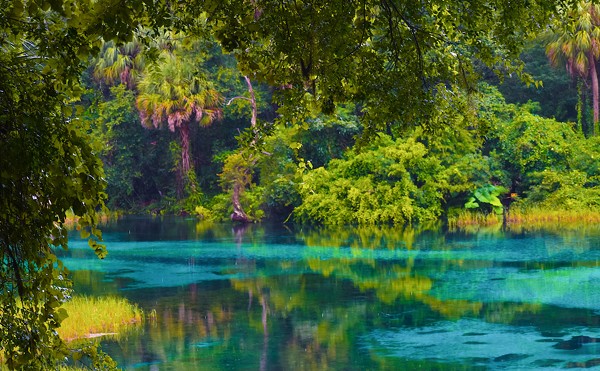Loss and YearningA number of the Cuban-American artists at Corbino Galleries turn away from the notion of escape, to the exile's invisible home in representations of religious yearning and spiritual knowledge. Paul Sierra, for example, says, "I don't see any justice in nature, no morals or right and wrong. These things are humanly imposed." His work "Epiphany," which hangs at the Museum of Art, Fort Lauderdale, with its big 5-and-a-half-foot-by-8-foot canvas and harsh palette of reds, greens, yellows and touches of blue and black, communicates a dramatic moment of nature's indifferent brutality. The trees, water and sky seem on fire, consuming the living and the dead. The epiphany is signified by white water falling, like light, from above.
"My brother meditates," says Sierra. "He has these moments of detachment," or epiphany, the revelation of a sense of timeless well being. "I haven't achieved that." On the wall at Corbino Galleries, Sierra's "Halcyon," conveys a similar idea. Though the word properly refers to the mythical bird of peace, the artist uses it to evoke the swimmer (a recurring figure for Sierra), which is simultaneously well formed and strangely embryonic, muscled but androgynous and surrounded in a softer but still dissonant psychedelic palette of incandescent tropical flora. The swimmer rides the river to the brink of a renewal that's spiritual or creative in essence and achieved by flowing with the water rather than against it.
Sierra left Cuba in 1961 at age 16 with his mother and brother to join his father in Miami. They soon moved to Chicago, where Cuban-Americans number about 11,000 and where he has remained since leaving Miami. He studied at the Art Institute of Chicago. As to how his experience of separation from homeland affects his work, he admits, "the loss of country, friends, identity, ambiance, the crumbling of society, it must be a kick, but I don't know how it shows itself." He says, "Art is a way to stay away from the psychiatrists and the bars." Maybe it transforms the pain. In the meantime Chicago is home for Sierra. He has no plans to return to Cuba, but he adds "a slow painful death" would be fine for Castro, to let nature be cruel to him, spiritually speaking.
Like Sierra, Baruj Salinas and Mario Bencomo make scant reference to Cuba in their art even though they were plenty old enough to have vivid memories when they left the island: Salinas in 1959 at age 21 and Bencomo in 1968 at age 14. Trained as an architect, Salinas splits his time between Miami and Barcelona. Bencomo lives in Miami and is part of the largest concentration of Cubans outside Cuba in the world.
Both artists pursue a transcendental effect. Incongruous to his training, Salinas paints as the anti-architect. His latest work is subtle in hue, shade and figure, but fast. It's as if you are looking at the subject, a palm or flower, caught in the horrific beauty of a typhoon, as if the mysterious logic of weather applied the paint. The canvas is whole and complex, and the more you look, the more you wonder at it, like poetry or God: something you might feel but never know.
Bencomo, on the other hand, goes for ambiguity and mystery but with the underlying precision of a draftsman, indeed, the sketch surely underlies the surface. His subjects are organic. As if filled with life juices, they seem to move in luminous color like light through a clerestory window, absent the familiar pictorial figures of the great religions. Thus mysticism, wonder and beauty overtake the traditions of concrete meaning and dogma. Like Sierra, these guys don't seem to kneel and pray. They pray as they create.
Julio Antonio shies neither from religion, in the indigenous sense, nor politics. Like several Corbino gallery artists, Antonio studied at Cuba's world-class art schools in Havana, the San Alejandro Academy of Fine Arts and the Superior Institute of Art — in total, about a 12-year course of study. He was part of Cuba's 1980s generation of artists that included Jose Bedea, Carlos Alfonzo, Agustin Cardenas, Ana Mendieta, Ana Albertina Delgado and many others who blew the doors down on the Soviet-style ideological cliches and control that had been Cuban policy in the 1970s.
Irony and SubterfugeMany in this generation left the country for Mexico, Spain and Miami, but they left behind a still-fresh wind of free expression that today's Cuban artists enjoy, though they still, to quote the late Carlos Alfonzo, "play the game" in which irony, humor and subterfuge are the rule. Nevertheless, since the '80s, Cubans have held the attention of the international art world. The art critic and historian Lucy Lippard writes: "It was never believed that a socialist republic could appear with a new exuberant art, that builds bridges between kitsch, folklore, popular religions, and postmodernism, an art that takes on the mestizaje and the syncretism which are also beginning to be major themes in North America ... a truly democratic impulse that excludes neither the history of art nor the formal advances of the West, nor the populist vitality of the developing nations."















